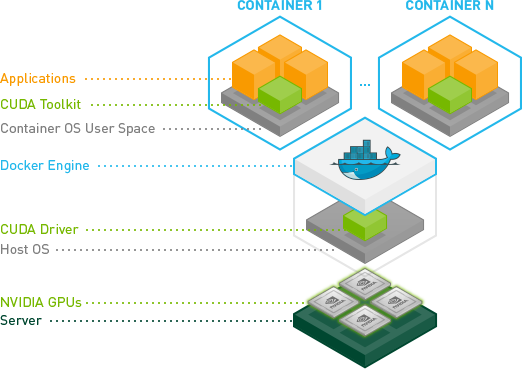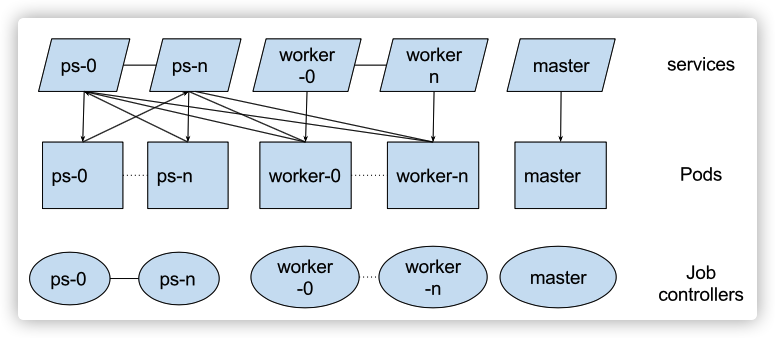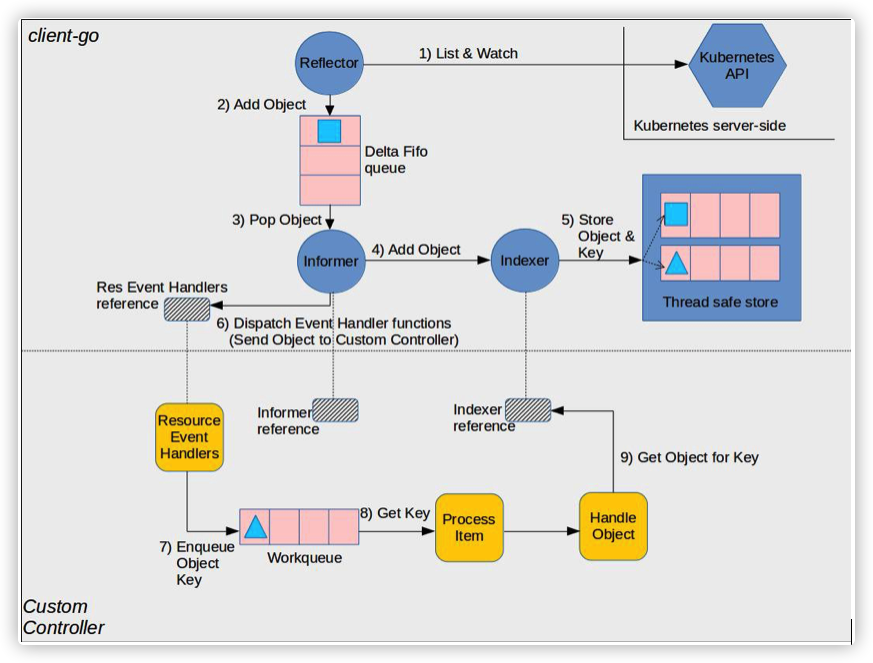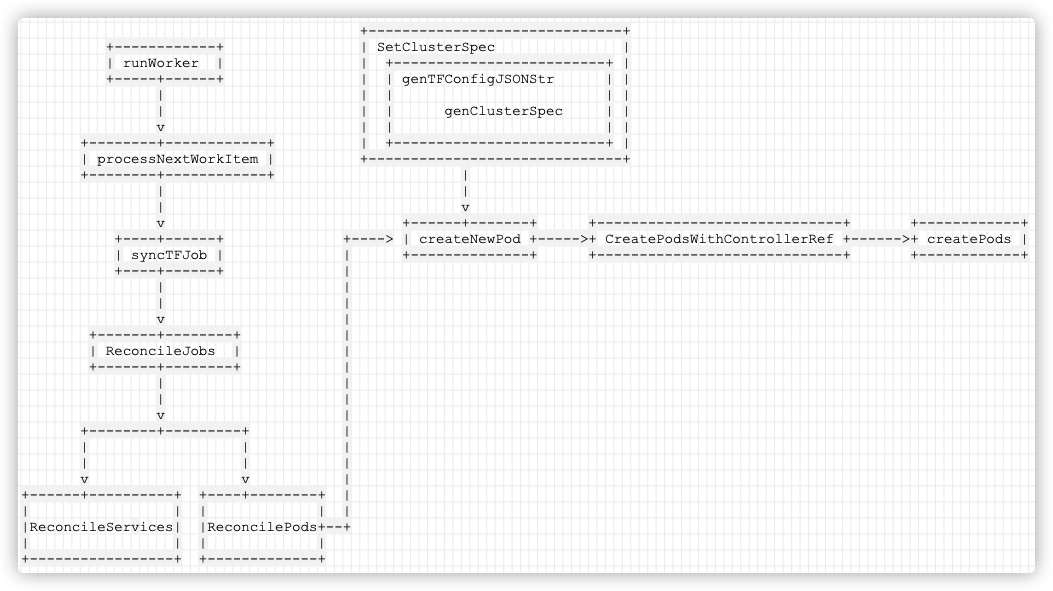[原始碼解析] 深度學習分散式訓練框架 horovod (18) --- kubeflow tf-operator
0x00 摘要
Horovod 是一款基於 AllReduce 的分散式訓練框架。憑藉其對 TensorFlow、PyTorch 等主流深度學習框架的支援,以及通訊優化等特點,Horovod 被廣泛應用於資料並行的訓練中。
前面通過十幾篇文章,我們一步一步分析了 Horovod 的方方面面。接下來就是面對 Horovod on K8S 這座大山。
本文以及後幾篇文章目的是:藉著分析學習 Horovod on K8S 功能,把相關概念梳理一遍,期望可以從中找出設計思路。所以成文方式是:整理學習了很多網上文章,然後自己分析程式碼。特此對各位作者深表感謝。
本文是 horovod on k8s 的餐前甜點和必備前提,介紹相關概念以及kubeflow 社群的 tf-operator。
本系列其他文章連結如下:
[原始碼解析] 深度學習分散式訓練框架 Horovod (1) --- 基礎知識
[原始碼解析] 深度學習分散式訓練框架 horovod (2) --- 從使用者角度切入
[原始碼解析] 深度學習分散式訓練框架 horovod (3) --- Horovodrun背後做了什麼
[原始碼解析] 深度學習分散式訓練框架 horovod (4) --- 網路基礎 & Driver
[原始碼解析] 深度學習分散式訓練框架 horovod (5) --- 融合框架
[原始碼解析] 深度學習分散式訓練框架 horovod (6) --- 後臺執行緒架構
[原始碼解析] 深度學習分散式訓練框架 horovod (7) --- DistributedOptimizer
[原始碼解析] 深度學習分散式訓練框架 horovod (8) --- on spark
[原始碼解析] 深度學習分散式訓練框架 horovod (9) --- 啟動 on spark
[原始碼解析] 深度學習分散式訓練框架 horovod (10) --- run on spark
[原始碼解析] 深度學習分散式訓練框架 horovod (11) --- on spark --- GLOO 方案
[原始碼解析] 深度學習分散式訓練框架 horovod (12) --- 彈性訓練總體架構
[原始碼解析] 深度學習分散式訓練框架 horovod (13) --- 彈性訓練之 Driver
[原始碼解析] 深度學習分散式訓練框架 horovod (14) --- 彈性訓練發現節點 & State
[原始碼解析] 深度學習分散式訓練框架 horovod (15) --- 廣播 & 通知
[原始碼解析] 深度學習分散式訓練框架 horovod (16) --- 彈性訓練之Worker生命週期
[原始碼解析] 深度學習分散式訓練框架 horovod (17) --- 彈性訓練之容錯
0x01 背景知識
1.1 Kubernetes
kubernetes,簡稱K8s,是用8代替8個字元“ubernete”而成的縮寫。是一個開源的,用於管理雲平臺中多個主機上的容器化的應用,Kubernetes的目標是讓部署容器化的應用簡單並且高效(powerful),Kubernetes提供了應用部署,規劃,更新,維護的一種機制。
Kubernetes 是一種越來越受歡迎的深度神經網路訓練選項,因為它提供了通過容器使用不同機器學習框架的靈活性,以及按需擴充套件的敏捷性。
當面臨較複雜的模型訓練或者資料量大時,單機的計算能力往往無法滿足算力要求。通過使用阿里的 AiACC 或者社群的 horovod 等分散式訓練框架,僅需修改幾行程式碼,就能將一個單機的訓練任務擴充套件為支援分散式的訓練任務。
在 Kubernetes 上常見的是 kubeflow 社群的 tf-operator 支援 Tensorflow PS 模式,或者 mpi-operator 支援 horovod 的 mpi allreduce 模式。
1.2 容器作為排程單元
為什麼希望使用容器來作為深度學習系統的排程單元?因為容器拉取/啟動快速。隔離資源效果好。抽象來看,可以將容器的image作為job的一部分分發排程執行。當然容器化後會引入gpu,網路等效能的代價。
比如 nvidia gpu 對docker提供了支援,nvidia-docker可以代替docker執行create和run操作。下圖就是nvidia-docker架構。

1.3 Kubeflow
Kubeflow 是一個開源的 Kubernetes 原生平臺,用於開發、編排、部署和執行可擴充套件的行動式機器學習工作負載。Kubeflow 可以在任何Kubernetes 叢集上執行。
Kubeflow可以很好的管理多機任務,Kubeflow的名字比較簡單,為Kubernetes + TensorFlow,是一個機器學習工具包,是執行在K8s之上的一套技術棧,這套技術棧包含了很多元件,元件之間的關係比較鬆散,我們可以配合起來用,也可以單獨用其中的一部分。
Kubeflow 詢問 Kubernetes 計劃分配哪幾臺機器來執行一個分散式作業中的各個程序,隨後告 知每個程序,所有其他程序的 IP 地址和 port。從而保證一個作業裡各個程序 之間互相知道對方。
為什麼需要讓所有程序互相知道對方呢?這是 TensorFlow ps-based distribution 方式要求的。TensorFlow 1.x 原生的分佈 式訓練功能讓一個作業中所有程序都執行 TensorFlow 1.x runtime 程式。這些 程序互相通訊,互相協調成為一個“分散式 runtime“,來解釋執行表示深度學習 計算過程的計算圖(graph)。在開始分散式訓練之初,graph 被 TensorFlow runtime 拆解成若干子圖;每個程序負責執行一個子圖 —— 任何一個程序失敗 (可能是被更高優先順序作業搶佔),則整個大圖的執行就失敗了。所以 TensorFlow 原生的分散式訓練能力不是容錯的(fault-tolerant)。不過, 它是可以從錯誤恢復(fault-recoverable)—— TensorFlow API 提供 checkpoint 的能力;如果一個作業失敗了,可以重啟作業,從最近的 checkpoint 開始繼續執行。
1.4 Tensorflow on Kubeflow
Kubeflow 支援兩種不同的 Tensorflow 框架分散式訓練方法。
- 第一種是原生 Tensorflow 架構,它依賴於集中式引數伺服器來實現工作執行緒之間的協調。
- 第二種是分散式方法,工作執行緒通過 MPI AllReduce 原語直接相互通訊,不使用引數伺服器。NVIDIA 的 NCCL 庫已經在GPU 上有效地執行了大部分 MPI 原語,而 Uber 的Horovod 讓使用 TensorFlow 執行多 GPU 和多節點訓練變得輕而易舉。與引數伺服器相比,第二種方法可以更好地優化頻寬和更好地擴充套件。
1.5 Operator
Operator 是Kubernetes 之中的概念,主要是用來打包、部署及管理使用者的任務。
Operator可以簡單理解為 CRD + Controller。
- CRD(Custom Resource Definition)是 Kubernetes 的擴充套件型別,用來為使用者自定義資源提。
- Controller 用來讓使用者操作CRD。
如果用 Java 來比喻,operator 就是 Class,CRD 就是類的成員變數,Controller 就是類成員方法。
1.6 TF-Operator
雖然KubeFlow提供了一大堆元件,涵蓋了機器學習的方方面面,但模型訓練肯定是KubeFlow最重要的功能。 KubeFlow針對各種各樣的機器學習框架提供了訓練的能力。方式是定義了各種各樣的Operator,其主要是用來管理機器學習或者深度學習裡面的任務,比如如何管理維護一個任務的多個節點,如何管理Pod及任務的生命週期,如何進行容錯等等。
TF-Operator就是開源社群基於K8S提供的擴充套件API,提供了TensorFlow的訓練能力,從名字也能看出來,這個實現是類似Job的一種方式,其特點如下:
- 提供TensorFlow原生PS-worker架構 的多機訓練
- 推薦將PS和worker一起啟動
- 通過service做服務發現
- 在社群中最早期的Operator
因為 TF-Operator 是社群中最早期的Operator,所以我們有必要先看看。
0x02 TensorFlow 分散式
因為 TF-Operator 是為了支援 Tensorflow PS 模式,所以我們首先介紹一下 TensorFlow 分散式。
2.1 Parameter server架構
在Parameter server架構(PS架構)中,叢集中的節點被分為兩類:引數伺服器(parameter server)和工作伺服器(worker)。其中引數伺服器存放模型的引數,而工作伺服器負責計算引數的梯度。在每個迭代過程,工作伺服器從引數伺服器中獲得引數,然後將計算的梯度返回給引數伺服器,引數伺服器聚合從工作伺服器傳回的梯度,然後更新引數,並將新的引數廣播給工作伺服器。
PS-Worker 架構的梯度更新有著 同步更新 和 非同步更新 兩種方式:
在同步訓練中, 所有的Worker裝置採用同一個Batch的不同小批(mini-batch)資料來訓練,等待所有裝置該批次的梯度計算完成後,模型才會根據所有的梯度進行一次引數更新,然後PS將更新後的模型下發到各個裝置。
非同步訓練中,沒有裝置需要去等待其他裝置的梯度計算和引數更新,所有裝置獨立算並與將梯度結果更新到中心節點(PS)。非同步訓練總體會訓練速度會快很多,但是非同步訓練的一個很嚴重的問題是梯度失效問題(stale gradients),剛開始所有裝置採用相同的引數來訓練,但是非同步情況下,某個裝置完成一步訓練後,可能發現模型引數已經被其它裝置更新過了,此時這個裝置計算出的梯度就過期了。
2.2 Tensorflow PS-Worker
2.2.1 架構
這裡只是大致介紹一下,主要是為了和 TF-Operator 對比。
TF 把Job主要劃分為Parameter Server和Worker(因為 TF 版本不同,所以有不同階段的特別定義,比如 master 或者 chief)。
- Parameter Job:執行模型相關的作業,包括模型引數儲存,分發,彙總,更新;作為分散式訓練的服務端,等到各個終端(supervisors)來連線。
- Worker Job: 在TensorFlow的程式碼註釋中被稱為supervisors,執行訓練相關的作業,包括推理計算和梯度計算。如果引數的數量太大,一臺機器處理不了,這就要需要多個Tasks(動態上理解,主機上的一個程序,從靜態的角度理解,
Task就是我們寫的程式碼)。 - Chief supervisors:在眾多運算終端中必須選中一個作為主要的運算終端。該終端是在運算終端中最先啟動的,它的功能是合併各個終端運算後的學習引數,將其儲存再寫入。
- Cluster 是 Jobs 的集合: Cluster(叢集) 就是集群系統。
每個具體角色網路標識都是唯一的,即分佈在不同IP的機器上(或者同一主機但不同埠號)。
在實際執行中,各個角色的網路構建部分程式碼必須完全相同,Ps-worker 架構分散式模型的流程大致如下:
pull : 各個worker根據資料流圖的拓撲結構,從PS拉取最新的模型引數
feed: 各worker填充不同的批資料
compute: 各worker按照相同的模型引數和不同的批資料計算梯度,得出不同的梯度值
push 各worker 將計算得到的梯度值上傳給PS
update: PS 收集所有worker的梯度值,求平均值,更新模型引數。
2.2.2 程式碼
具體邏輯如下:
Task需要知道叢集上都有哪些主機,以及它們都監聽什麼埠。tf.train.ClusterSpec()就是用來描述這個。- 這個
Cluster(叢集)有兩個Job(worker.ps),worker中有三個Task(即,有三個Task執行Tensorflow op操作) - 將
ClusterSpec當作引數傳入到tf.train.Server()中,同時指定此Task的Job_name和task_index。 - 由於是相同的程式碼執行在不同的主機上,所以要傳入
job_name和task_index加以區分,而ps_hosts和worker_hosts對於所有主機來說,都是一樣的,用來描述叢集的。 - 一個tf.train.Server包含了本地裝置(GPUs,CPUs)的集合,可以連線到到其它task的ip:port(儲存在cluster中), 還有一個session target用來執行分佈操作。還有最重要的一點就是,它建立了一個伺服器,監聽port埠,如果有資料傳過來,他就會在本地執行(啟動session target,呼叫本地裝置執行運算),然後結果返回給呼叫者。
- 為了使ps_server能夠一直處於監聽狀態,我們需要使用server.join()。這時,程序就會block在這裡.至於為什麼ps_server剛建立就join呢,原因是因為下面的程式碼會將引數指定給ps_server保管,所以ps_server靜靜的監聽就好了。
# To build a cluster with two ps jobs on hosts ps0 and ps1, and 3 worker
# jobs on hosts worker0, worker1 and worker2.
cluster_spec = {
"ps": ["ps0:2222", "ps1:2222"],
"worker": ["worker0:2222", "worker1:2222", "worker2:2222"]}
# Create a cluster from the parameter server and worker hosts.
cluster = tf.train.ClusterSpec({"ps": ps_hosts, "worker": worker_hosts})
# Create and start a server for the local task.
server = tf.train.Server(cluster,
job_name=FLAGS.job_name,
task_index=FLAGS.task_index)
if FLAGS.job_name == "ps":
server.join()
稍微完整點的程式碼如下:
def main(_):
ps_hosts = FLAGS.ps_hosts.split(",")
worker_hosts = FLAGS.worker_hosts.split(",")
# Create a cluster from the parameter server and worker hosts.
cluster = tf.train.ClusterSpec({"ps": ps_hosts, "worker": worker_hosts})
# Create and start a server for the local task.
server = tf.train.Server(cluster,
job_name=FLAGS.job_name,
task_index=FLAGS.task_index)
if FLAGS.job_name == "ps":
server.join()
elif FLAGS.job_name == "worker":
# 找出worker的主節點,即task_index為0的節點
is_chief = (FLAGS.task_index == 0)
# Assigns ops to the local worker by default.
with tf.device(tf.train.replica_device_setter(
worker_device="/job:worker/task:%d" % FLAGS.task_index,
cluster=cluster)):
# Compute
執行如下,可以看出,我們只需要寫一個程式,在不同的主機上,傳入不同的引數使其執行:
# On ps0.example.com:
$ python trainer.py \
--ps_hosts=ps0.example.com:2222,ps1.example.com:2222 \
--worker_hosts=worker0.example.com:2222,worker1.example.com:2222 \
--job_name=ps --task_index=0
# On ps1.example.com:
$ python trainer.py \
--ps_hosts=ps0.example.com:2222,ps1.example.com:2222 \
--worker_hosts=worker0.example.com:2222,worker1.example.com:2222 \
--job_name=ps --task_index=1
# On worker0.example.com:
$ python trainer.py \
--ps_hosts=ps0.example.com:2222,ps1.example.com:2222 \
--worker_hosts=worker0.example.com:2222,worker1.example.com:2222 \
--job_name=worker --task_index=0
# On worker1.example.com:
$ python trainer.py \
--ps_hosts=ps0.example.com:2222,ps1.example.com:2222 \
--worker_hosts=worker0.example.com:2222,worker1.example.com:2222 \
--job_name=worker --task_index=1
0x03 TF-Operator
3.1 TF-Operator 設計思路
瞭解了 TF 分散式的大致運作,我們來看看 TF-Operator 設計思路。
以下是從 "Design Doc TFJob K8s CRD" 中翻譯的。
目標是使在Kubernetes(K8s)上執行TensorFlow訓練(尤其是分散式訓練)變得容易。我建議通過建立一個K8s自定義資源描述符(CRD)和關聯的控制器來實現這一點。CRD負責管理執行培訓作業所需的K8s資源。
Kubernetes通過提供一個流程(而不是以VM為中心)的世界檢視,使得管理流程變得更加容易。Kubernetes還為複雜的分散式應用程式提供了基本的構建塊。例如,K8s提供對DNS、健康檢查、日誌收集、度量收集、儲存等的內建支援。
在K8s中,控制器負責確保一套Pods是執行狀態。Pod是K8s中的基本構建塊,它描述了一個或多個應該進行共定位的程序(相同的ip)。K8s配備了許多內建控制器。可以確保N個pod以特定的規範執行。作業控制器可以用來執行二進位制檔案。
內建控制器不足以執行分散式TensorFlow作業。TensorFlow是一個有狀態的應用程式;每個引數伺服器和工作者都需要具有唯一的可定址性,以支援所有不同的分散式培訓模式。K8s有一個statefulset。 但是,有狀態集用於永久執行的有狀態服務(如Redis之類的記憶體分片快取服務),而不是用於執行到完成的作業。
因此,今天在K8s上執行分散式TF作業意味著從內建原語中拼湊出一個解決方案。通常,這意味著手動管理多個資源。例如,使用者可以為引數伺服器建立一個有狀態集,為工作者建立一個有狀態集,為主伺服器建立一個作業。
為了解決內建資源的限制,K8s支援自定義資源(CRD)和控制器。使用CRD,可以很容易地為特定工作負載建立具有所需語義的控制器,同時將使用者隱藏在實現中。K8s社群很快就採用了這種模式,貢獻了大量的CRD用於各種工作負載。
開發crd和各種控制器的K8s團隊的意見是,大多數控制器使用非分散式、多執行緒設計,可伸縮性不是問題。
TFJob CRD為K8s定義了TFJob資源。
TFJob資源是 TfReplicas 的集合。每個TfReplica對應一個在工作中扮演角色的一組 TensorFlow processes;
我做出了一個明確的決定,不試圖隱藏或替換K8s抽象。例如,每個TfReplica都包含一個標準的K8s PodTemplate 以指定要在每個複製副本中執行的程序(包括TF)。我這樣做是因為K8s已經提供了一個被廣泛採用和理解的API。因此,引入新的概念來代替K8s的概念是令人困惑的。此外,公開PodTemplate 使TFJob使用者可以輕鬆地利用K8s特性。例如,TFJob使用者可以使用K8s將卷附加到其TF程序。這使得TF與K8s支援的任何儲存系統(如PDs、NFS等)結合使用變得非常容易。
3.2 架構圖
具體架構圖如下:

3.2.1 什麼是Pod
我們從圖上來看,先看中間的 pod 概念。
pod 是 k8s排程的最小單元。pod 可以理解為:容器組,同時pod相當於邏輯主機,進入pod後彷彿進入一個linux主機,命令都可用(linux系統下),該“主機”內又有很多容器,進入後又彷彿是又進了一個linux主機。預設情況下,每個容器的檔案系統與其他容器完全隔離。每個pod都有自己的ip地址。pod內的容器共享相同的ip和埠空間。
3.2.2 為什麼要有 service
首先,每個Pod都會被分配一個單獨的IP地址,而且每個Pod都提供了一個獨立的Endpoint(Pod IP + ContainerPort)以被客戶端訪問,但這種訪問僅限於叢集內部,外部沒法訪問叢集內部的IP地址,
其次,Pod的生命是有限的,如果Pod重啟IP很有可能會發生變化。當 controller 用新 Pod 替代發生故障的 Pod 時,新 Pod 會分配到新的 IP 地址。這樣就產生了一個問題:如果一組 Pod 對外提供服務(比如 HTTP),它們的 IP 很有可能發生變化,那麼客戶端如何找到並訪問這個服務呢?
Kubernetes 給出的解決方案是 Service。
Service只是一個抽象概念,Kubernetes Service 從邏輯上代表了一組 Pod,具體是哪些 Pod 則是由 label 來挑選。Service 在邏輯上將一組pod(功能相同)給抽象出來一個統一入口。可以將他簡單理解為做了一個服務的負載均衡。
Service 有自己 IP,而且這個 IP 是不變的。客戶端只需要訪問 Service 的 IP,Kubernetes 則負責建立和維護 Service 與 Pod 的對映關係。無論後端 Pod 如何變化,對客戶端不會有任何影響,因為 Service 沒有變。所以一般會通過service來訪問pod。core-dns會給service分配一個內部的虛擬ip,因此內部服務可以通過這個ip或者是serviceName來訪問到pod的服務。
我們給出一個原始碼中的service 例子。
apiVersion: v1
kind: Service
metadata:
annotations:
prometheus.io/path: /metrics
prometheus.io/scrape: "true"
prometheus.io/port: "8443"
labels:
app: tf-job-operator
name: tf-job-operator
spec:
ports:
- name: monitoring-port
port: 8443
targetPort: 8443
selector:
name: tf-job-operator
type: ClusterIP
現在我們看到已經建立了名為tf-job-operator的Service,會分配一個Cluster IP,該Service還會持續的監聽selector下面的 Pod,會把這些Pod資訊更新到一個名為 tf-job-operator 的Endpoints物件上去,這個物件就類似於我們上面說的Pod集合了。
3.2.3 什麼是 controller
因為 Kubernetes 現有的資源型別無法滿足我們的需求,因此需要通過 Custom Resource Definition 的機制進行擴充套件。
K8S中一切都是resource,比如Deployment,Service等等。
我們可以基於CRD(CustomResourceDefinitions)功能新增resource,比如我想自定義一種Deployment資源,提供不同的部署策略。
我們知道resource可以通過k8s的RESTFUL API進行CURD操作,對於CRD建立的resource也是一樣的。
CRD僅僅是定義一種resource,我們還需要實現controller,類似於deployment controller等等,監聽對應資源的CURD事件,做出對應的處理,比如部署POD。

其實,TF-Operator 主要就是一個 Controller 的實現,我們下面也主要就是講解這個 controller。
3.3 Spec
我們首先給出一個 Job Spec,這樣大家可以在後續和程式碼中對應。樣例如下,擁有一個 master,2個 workers,一個 PS。
apiVersion: "kubeflow.org/v1alpha1" # 指定api版本,此值必須在kubectl api-versions中
kind: "TFJob" # 指定建立資源的角色/型別
metadata: # 資源的元資料/屬性
name: "example-job"
spec: # 資源規範字段
replicaSpecs: # 宣告副本數目
- replicas: 1
tfReplicaType: MASTER
template: # 模版
spec:
containers:
- image: gcr.io/tf-on-k8s-dogfood/tf_sample:dc944ff # 容器使用的映象地址
name: tensorflow
args:
- --log_dir=gs://my-job/log-dir
restartPolicy: OnFailure
- replicas: 2
tfReplicaType: WORKER
template:
spec:
containers:
- image: gcr.io/tf-on-k8s-dogfood/tf_sample:dc944ff
name: tensorflow
args:
- --log_dir=gs://my-job/log-dir
restartPolicy: OnFailure
- replicas: 1
tfReplicaType: PS
下面我們開始進入程式碼世界。
3.4 TFJob
首先我們看看 TFJob 的定義,大致可以和上面的 Spec 中找到對應關係,因為本文目的是瞭解其大略,所以我們就只分析這些即可。
// TFJob represents a TFJob resource.
type TFJob struct {
// Standard Kubernetes type metadata.
metav1.TypeMeta `json:",inline"`
// Standard Kubernetes object's metadata.
// +optional
metav1.ObjectMeta `json:"metadata,omitempty"`
// Specification of the desired state of the TFJob.
// +optional
Spec TFJobSpec `json:"spec,omitempty"`
// Most recently observed status of the TFJob.
// Populated by the system.
// Read-only.
// +optional
Status commonv1.JobStatus `json:"status,omitempty"`
}
// TFJobSpec is a desired state description of the TFJob.
type TFJobSpec struct {
// RunPolicy encapsulates various runtime policies of the distributed training
// job, for example how to clean up resources and how long the job can stay
// active.
RunPolicy commonv1.RunPolicy `json:"runPolicy,inline"`
// SuccessPolicy defines the policy to mark the TFJob as succeeded.
// Default to "", using the default rules.
// +optional
SuccessPolicy *SuccessPolicy `json:"successPolicy,omitempty"`
// A map of TFReplicaType (type) to ReplicaSpec (value). Specifies the TF cluster configuration.
// For example,
// {
// "PS": ReplicaSpec,
// "Worker": ReplicaSpec,
// }
TFReplicaSpecs map[commonv1.ReplicaType]*commonv1.ReplicaSpec `json:"tfReplicaSpecs"`
// // A switch to enable dynamic worker
EnableDynamicWorker bool `json:"enableDynamicWorker,omitempty"`
}
3.5 角色
其次我們看看 TF-Operator 之中,對 TF 角色的對應實現。
3.5.1 定義
首先是角色定義。這裡的角色基本對應了 Tensorflow 的各個角色,包括很多為了相容而保留的角色。
// setTypeNamesToCamelCase sets the name of all replica types from any case to correct case.
func setTypeNamesToCamelCase(tfJob *TFJob) {
setTypeNameToCamelCase(tfJob, TFReplicaTypePS)
setTypeNameToCamelCase(tfJob, TFReplicaTypeWorker)
setTypeNameToCamelCase(tfJob, TFReplicaTypeChief)
setTypeNameToCamelCase(tfJob, TFReplicaTypeMaster)
setTypeNameToCamelCase(tfJob, TFReplicaTypeEval)
}
const (
// TFReplicaTypePS is the type for parameter servers of distributed TensorFlow.
TFReplicaTypePS commonv1.ReplicaType = "PS"
// TFReplicaTypeWorker is the type for workers of distributed TensorFlow.
// This is also used for non-distributed TensorFlow.
TFReplicaTypeWorker commonv1.ReplicaType = "Worker"
// TFReplicaTypeChief is the type for chief worker of distributed TensorFlow.
// If there is "chief" replica type, it's the "chief worker".
// Else, worker:0 is the chief worker.
TFReplicaTypeChief commonv1.ReplicaType = "Chief"
// TFReplicaTypeMaster is the type for master worker of distributed TensorFlow.
// This is similar to chief, and kept just for backwards compatibility.
TFReplicaTypeMaster commonv1.ReplicaType = "Master"
// TFReplicaTypeEval is the type for evaluation replica in TensorFlow.
TFReplicaTypeEval commonv1.ReplicaType = "Evaluator"
)
3.5.2 建立角色
NewTFJobV2 函式就是依據配置的不同,來建立不同的角色。
這裡可以看到,生成 job 時候,基本就是按照 spec 的對應欄位來處理。
apiVersion: "kubeflow.org/v1alpha1"
kind: "TFJob"
metadata:
name: "example-job"
spec:
replicaSpecs:
下面是函式定義。
func NewTFJobV2(worker, ps, master, cheif, evaluator int) *tfv1.TFJob {
tfJob := &tfv1.TFJob{
TypeMeta: metav1.TypeMeta{
Kind: tfv1.Kind,
},
ObjectMeta: metav1.ObjectMeta{
Name: TestTFJobName,
Namespace: metav1.NamespaceDefault,
},
Spec: tfv1.TFJobSpec{
TFReplicaSpecs: make(map[commonv1.ReplicaType]*commonv1.ReplicaSpec),
},
}
tfv1.SetObjectDefaults_TFJob(tfJob)
if worker > 0 {
worker := int32(worker)
workerReplicaSpec := &commonv1.ReplicaSpec{
Replicas: &worker,
Template: NewTFReplicaSpecTemplate(),
}
tfJob.Spec.TFReplicaSpecs[tfv1.TFReplicaTypeWorker] = workerReplicaSpec
}
if ps > 0 {
ps := int32(ps)
psReplicaSpec := &commonv1.ReplicaSpec{
Replicas: &ps,
Template: NewTFReplicaSpecTemplate(),
}
tfJob.Spec.TFReplicaSpecs[tfv1.TFReplicaTypePS] = psReplicaSpec
}
if master > 0 {
master := int32(master)
masterReplicaSpec := &commonv1.ReplicaSpec{
Replicas: &master,
Template: NewTFReplicaSpecTemplate(),
}
tfJob.Spec.TFReplicaSpecs[tfv1.TFReplicaTypeMaster] = masterReplicaSpec
}
if cheif > 0 {
cheif := int32(cheif)
cheifReplicaSpec := &commonv1.ReplicaSpec{
Replicas: &cheif,
Template: NewTFReplicaSpecTemplate(),
}
tfJob.Spec.TFReplicaSpecs[tfv1.TFReplicaTypeChief] = cheifReplicaSpec
}
if evaluator > 0 {
evaluator := int32(evaluator)
evaluatorReplicaSpec := &commonv1.ReplicaSpec{
Replicas: &evaluator,
Template: NewTFReplicaSpecTemplate(),
}
tfJob.Spec.TFReplicaSpecs[tfv1.TFReplicaTypeChief] = evaluatorReplicaSpec
}
return tfJob
}
3.5.3 如何區分 master
用如下方法區分 master。
func (tc *TFController) IsMasterRole(replicas map[commonv1.ReplicaType]*commonv1.ReplicaSpec, rtype commonv1.ReplicaType, index int) bool {
if ContainChieforMasterSpec(replicas) {
return rtype == tfv1.TFReplicaTypeChief || rtype == tfv1.TFReplicaTypeMaster
}
// else check if it is worker with index 0
return rtype == tfv1.TFReplicaTypeWorker && index == 0
}
0x04 Contoller
下面就進入正題,看看 Controller 如何實現。
4.1 K8S CRD關鍵概念
首先我們需要看看 K8S CRD 的一些關鍵概念。
informer:監聽apiserver中特定資源變化,然後會儲存到一個執行緒安全的local cache中,最後回撥我們自己實現的event handler。
local cache:informer實時同步apiserver(也就是etcd)中的資料到記憶體中儲存,可以有效降低apiserver的查詢壓力,但缺點就是實時性不好,本地會比遠端的資料落後一點點但會最終與etcd一致,所以需要根據情況具體分析是走Local cache還是apiserver實時獲取資料。
Lister:提供了CURD操作訪問local cache。
controller:一個邏輯概念,就是指排程某種資源的實現而已,需要我們自己開發。Controller做的事情主要包括:
- 實現event handler處理資源的CURD操作
- 在event handler,可以使用workqueue類庫實現相同資源物件的連續event的去重,以及event處理異常後的失敗重試,通常是建議使用的。
Workqueue:一個單獨的類庫,是可選使用的,但通常都會使用,原因上面說了。我們需要在實現event handler的時候把發生變化的資源標識放入workqueue,供下面的processor消費。
Clientset:預設clientset只能CRUD k8s提供的資源型別,比如deployments,daemonset等;生成的程式碼為我們自定義的資源(CRD)生成了單獨的clientset,從而讓我們使用結構化的程式碼CURD自定義資源。也就是說,想操作內建資源就用k8s自帶的clientset,想操作CRD就用生成程式碼裡的clientset。
Processor:我們實現的go協程,消費workqueue中的事件,workqueue提供了按資源標識的去重。
4.2 定義
TFController 的定義如下,可以看出來幾個成員變數各有所用,就分別用到了上述的部分元件。
// TFController is the type for TFJob Controller, which manages
// the lifecycle of TFJobs.
type TFController struct {
common.JobController
// tfJobClientSet is a clientset for CRD TFJob.
tfJobClientSet tfjobclientset.Interface
// To allow injection of sync functions for testing.
syncHandler func(string) (bool, error)
// tfJobInformer is a temporary field for unstructured informer support.
tfJobInformer cache.SharedIndexInformer
// Listers for TFJob, Pod and Service
// tfJobLister can list/get tfjobs from the shared informer's store.
tfJobLister tfjoblisters.TFJobLister
// tfJobInformerSynced returns true if the tfjob store has been synced at least once.
tfJobInformerSynced cache.InformerSynced
}
4.3 入口
TF-Operator 邏輯程式碼的入口是 runWorker,其實就是迴圈呼叫 processNextWorkItem。
func (tc *TFController) runWorker() {
for tc.processNextWorkItem() {
}
}
processNextWorkItem將從WorkQueue中讀取單個工作項,並嘗試通過呼叫syncHandler來處理它。
// processNextWorkItem will read a single work item off the workqueue and
// attempt to process it, by calling the syncHandler.
func (tc *TFController) processNextWorkItem() bool {
obj, quit := tc.WorkQueue.Get()
if key, ok = obj.(string); !ok {
tc.WorkQueue.Forget(obj)
return true
}
tfJob, err := tc.getTFJobFromKey(key)
// 同步TFJob以將實際狀態匹配到所需的狀態。
// Sync TFJob to match the actual state to this desired state.
forget, err := tc.syncHandler(key)
}
4.4 syncHandler
syncHandler 的作用是依據 key 來同步 Job,就是從 WorkQueue 之中弄出來一個 job,本地處理。
之前設定有 tc.syncHandler = tc.syncTFJob,所以我們實際來到了 syncTFJob。
- 如果
tfjob的期望值已經實現,那麼syncTFJob就會用給定的key來同步tfjob,這意味著它不希望更多的
pod/service被建立或刪除: - EnableDynamicWorker 這裡會根據不同型別設定。
- 然後會呼叫 ReconcileJobs 對具體 job 進行處理。
// syncTFJob syncs the tfjob with the given key if it has had its expectations fulfilled, meaning
// it did not expect to see any more of its pods/services created or deleted.
// This function is not meant to be invoked concurrently with the same key.
// 這個函式不能與同一個key同時呼叫
func (tc *TFController) syncTFJob(key string) (bool, error) {
namespace, name, err := cache.SplitMetaNamespaceKey(key)
sharedTFJob, err := tc.getTFJobFromName(namespace, name)
tfjob := sharedTFJob.DeepCopy()
// Sync tfjob every time if EnableDynamicWorker is true
tfjobNeedsSync := tfjob.Spec.EnableDynamicWorker || tc.satisfiedExpectations(tfjob)
// 為新tfjob設定預設值。
// Set default for the new tfjob.
scheme.Scheme.Default(tfjob)
if tfjobNeedsSync && tfjob.DeletionTimestamp == nil {
// 呼叫reconcileTFJobs來啟動TFJobs
reconcileTFJobsErr = tc.ReconcileJobs(tfjob, tfjob.Spec.TFReplicaSpecs, tfjob.Status, &tfjob.Spec.RunPolicy)
}
return true, err
}
4.5 ReconcileJobs
reconcileTFJobs檢查並更新每個給定TFReplicaSpec的replicas,並且做相應處理,可以認為這裡是主控邏輯。
- 如果 job 結束,則做相應處理,delete所有pod和service。
- 如果TFJob超過了backofflimit或超過了active deadline,刪除所有pod和service,然後將狀態設定為failed。
- 否則 遍歷配置檔案的TFReplicaSpecs部分,
- 分別為不同型別的節點啟動相應的Pod。
- 在啟動Pod之後,還要為其啟動一個Service。
// 如果在建立/刪除 pods/services時發生錯誤,它將請求tfjob。
// ReconcileJobs checks and updates replicas for each given ReplicaSpec.
// It will requeue the job in case of an error while creating/deleting pods/services.
func (jc *JobController) ReconcileJobs(
job interface{},
replicas map[apiv1.ReplicaType]*apiv1.ReplicaSpec,
jobStatus apiv1.JobStatus,
runPolicy *apiv1.RunPolicy) error {
metaObject, ok := job.(metav1.Object)
jobName := metaObject.GetName()
runtimeObject, ok := job.(runtime.Object)
jobKey, err := KeyFunc(job)
pods, err := jc.Controller.GetPodsForJob(job)
services, err := jc.Controller.GetServicesForJob(job)
oldStatus := jobStatus.DeepCopy()
// 如果TFJob terminated,則delete所有pod和service。
if commonutil.IsSucceeded(jobStatus) || commonutil.IsFailed(jobStatus) {
// If the Job is succeed or failed, delete all pods and services.
jc.DeletePodsAndServices(runPolicy, job, pods)
jc.CleanupJob(runPolicy, jobStatus, job)
return nil
}
// 檢索以前的重試次數
// retrieve the previous number of retry
previousRetry := jc.WorkQueue.NumRequeues(jobKey)
activePods := k8sutil.FilterActivePods(pods)
jc.recordAbnormalPods(activePods, runtimeObject)
active := int32(len(activePods))
failed := k8sutil.FilterPodCount(pods, v1.PodFailed)
totalReplicas := k8sutil.GetTotalReplicas(replicas)
prevReplicasFailedNum := k8sutil.GetTotalFailedReplicas(jobStatus.ReplicaStatuses)
if jobExceedsLimit {
// If the Job exceeds backoff limit or is past active deadline
// delete all pods and services, then set the status to failed
jc.DeletePodsAndServices(runPolicy, job, pods); err != nil {
jc.CleanupJob(runPolicy, jobStatus, job); err != nil {
jc.Recorder.Event(runtimeObject, v1.EventTypeNormal, commonutil.JobFailedReason, failureMessage)
commonutil.UpdateJobConditions(&jobStatus, apiv1.JobFailed, commonutil.JobFailedReason, failureMessage)
return jc.Controller.UpdateJobStatusInApiServer(job, &jobStatus)
} else {
// General cases which need to reconcile
if jc.Config.EnableGangScheduling {
minAvailableReplicas := totalReplicas
_, err := jc.SyncPodGroup(metaObject, minAvailableReplicas)
}
// 遍歷配置檔案的TFReplicaSpecs部分,分別為不同型別的節點啟動相應的Pod。
// 在啟動Pod之後,還要為其啟動一個Service。
// Diff current active pods/services with replicas.
for rtype, spec := range replicas {
err := jc.Controller.ReconcilePods(metaObject, &jobStatus, pods, rtype, spec, replicas)
err = jc.Controller.ReconcileServices(metaObject, services, rtype, spec)
}
}
err = jc.Controller.UpdateJobStatus(job, replicas, &jobStatus)
// No need to update the job status if the status hasn't changed since last time.
if !reflect.DeepEqual(*oldStatus, jobStatus) {
return jc.Controller.UpdateJobStatusInApiServer(job, &jobStatus)
}
return nil
}
目前邏輯如下:
+------------+
| runWorker |
+-----+------+
|
|
v
+--------+------------+
| processNextWorkItem |
+--------+------------+
|
|
v
+----+------+
| syncTFJob |
+----+------+
|
|
v
+-------+--------+
| ReconcileJobs |
+-------+--------+
|
|
v
+--------+---------+
| |
| |
v v
+---------+---------+ +-----+--------+
| | | |
| ReconcileServices | |ReconcilePods |
| | | |
+-------------------+ +--------------+
下面我們分別介紹處理 Pod 和 處理 Service。
4.6 處理 Pod
4.6.1 ReconcilePods
reconcilePods為每個給定的TFReplicaSpec檢查和更新pod。
具體比如:
- 初始化 replica 的狀態;
- 如果master pod存在,選擇master pod,如果沒有master,第一個worker pod被選為master;
- createNewPod 來建立新的 pod;
- 或者刪除 pod;
// reconcilePods checks and updates pods for each given TFReplicaSpec.
// It will requeue the tfjob in case of an error while creating/deleting pods.
func (tc *TFController) ReconcilePods(
job interface{},
jobStatus *commonv1.JobStatus,
pods []*v1.Pod,
rtype commonv1.ReplicaType,
spec *commonv1.ReplicaSpec,
replicas map[commonv1.ReplicaType]*commonv1.ReplicaSpec,
) error {
tfJob, ok := job.(*tfv1.TFJob)
// Convert ReplicaType to lower string.
rt := strings.ToLower(string(rtype))
// 獲取rtype型別的所有pod。
pods, err := tc.FilterPodsForReplicaType(pods, rt)
numReplicas := int(*spec.Replicas)
masterRole := false
initializeReplicaStatuses(jobStatus, rtype)
// GetPodSlices will return enough information here to make decision to add/remove/update resources.
// For example, let's assume we have pods with replica-index 0, 1, 2
// If replica is 4, return a slice with size 4. [[0],[1],[2],[]], a pod with replica-index 3 will be created.
// If replica is 1, return a slice with size 3. [[0],[1],[2]], pod with replica-index 1 and 2 are out of range and will be deleted.
podSlices := tc.GetPodSlices(pods, numReplicas, logger)
for index, podSlice := range podSlices {
if len(podSlice) > 1 {
logger.Warningf("We have too many pods for %s %d", rt, index)
} else if len(podSlice) == 0 {
// 如果master pod存在,選擇master pod
// 如果沒有master,第一個worker pod被選為master。
// check if this replica is the master role
masterRole = tc.IsMasterRole(replicas, rtype, index)
// TODO: [should change to CreateNewPod]
err = tc.createNewPod(tfJob, rt, strconv.Itoa(index), spec, masterRole, replicas)
} else {
// Check the status of the current pod.
pod := podSlice[0]
// 目前只允許縮減workers
// check if the index is in the valid range, if not, we should kill the pod
if index < 0 || index >= numReplicas {
err = tc.PodControl.DeletePod(pod.Namespace, pod.Name, tfJob)
}
// Check if the pod is retryable.
if spec.RestartPolicy == commonv1.RestartPolicyExitCode {
if pod.Status.Phase == v1.PodFailed && train_util.IsRetryableExitCode(exitCode) {
tc.Recorder.Event(tfJob, corev1.EventTypeWarning, tfJobRestartingReason, msg)
err := commonutil.UpdateJobConditions(jobStatus, commonv1.JobRestarting, tfJobRestartingReason, msg)
tfJobsRestartCount.Inc()
}
}
updateJobReplicaStatuses(jobStatus, rtype, pod)
}
}
return nil
}
4.6.2 createNewPod
createNewPod為給定的index和type建立一個新的pod:
// createNewPod creates a new pod for the given index and type.
func (tc *TFController) createNewPod(tfjob *tfv1.TFJob, rt, index string, spec *commonv1.ReplicaSpec, masterRole bool,
replicas map[commonv1.ReplicaType]*commonv1.ReplicaSpec) error {
tfjobKey, err := KeyFunc(tfjob)
expectationPodsKey := expectation.GenExpectationPodsKey(tfjobKey, rt)
// Create OwnerReference.
controllerRef := tc.GenOwnerReference(tfjob)
// Set type and index for the worker.
labels := tc.GenLabels(tfjob.Name)
labels[tfReplicaTypeLabel] = rt
labels[tfReplicaIndexLabel] = index
podTemplate := spec.Template.DeepCopy()
// Set name for the template.
podTemplate.Name = common.GenGeneralName(tfjob.Name, rt, index)
if podTemplate.Labels == nil {
podTemplate.Labels = make(map[string]string)
}
for key, value := range labels {
podTemplate.Labels[key] = value
}
// 生成叢集的配置資訊,這裡最關鍵,看一下實現
if err := tc.SetClusterSpec(tfjob, podTemplate, rt, index); err != nil {
return err
}
// if gang-scheduling is enabled:
// 1. if user has specified other scheduler, we report a warning without overriding any fields.
// 2. if no SchedulerName is set for pods, then we set the SchedulerName to "kube-batch".
if tc.Config.EnableGangScheduling {
if isNonGangSchedulerSet(replicas) {
tc.Recorder.Event(tfjob, v1.EventTypeWarning, podTemplateSchedulerNameReason, errMsg)
} else {
podTemplate.Spec.SchedulerName = gangSchedulerName
}
if podTemplate.Annotations == nil {
podTemplate.Annotations = map[string]string{}
}
podTemplate.Annotations[gangSchedulingPodGroupAnnotation] = tfjob.GetName()
podTemplate.Annotations[volcanoTaskSpecKey] = rt
}
// 使用上面的配置資訊,真正啟動Pod的建立
err = tc.PodControl.CreatePodsWithControllerRef(tfjob.Namespace, podTemplate, tfjob, controllerRef)
return nil
}
4.6.3 生成配置資訊
4.6.3.1 SetClusterSpec
上面函式中的生成配置資訊比較重要,所以我們單獨摘出來說一下。
setClusterSpec為給定的podTemplateSpec生成並設定TF_CONFIG:
// SetClusterSpec generates and sets TF_CONFIG for the given podTemplateSpec.
func (tc *TFController) SetClusterSpec(job interface{}, podTemplate *v1.PodTemplateSpec, rtype, index string) error {
tfjob, ok := job.(*tfv1.TFJob)
// Generate TF_CONFIG JSON string.
tfConfigStr, err := genTFConfigJSONStr(tfjob, rtype, index)
// Add TF_CONFIG environment variable to tensorflow container in the pod.
for i := range podTemplate.Spec.Containers {
if podTemplate.Spec.Containers[i].Name == tfv1.DefaultContainerName {
if len(podTemplate.Spec.Containers[i].Env) == 0 {
podTemplate.Spec.Containers[i].Env = make([]v1.EnvVar, 0)
}
podTemplate.Spec.Containers[i].Env = append(podTemplate.Spec.Containers[i].Env, v1.EnvVar{
Name: tfConfig,
Value: tfConfigStr,
})
break
}
}
return nil
}
4.6.3.2 genTFConfigJSONStr
genTFConfigJSONStr 會生成 json 資料。
// genTFConfig will generate the environment variable TF_CONFIG
// {
// "cluster": {
// "ps": ["ps1:2222", "ps2:2222"],
// "worker": ["worker1:2222", "worker2:2222", "worker3:2222"]
// },
// "task": {
// "type": "ps",
// "index": 1
// },
// }
// }
func genTFConfigJSONStr(tfjob *tfv1.TFJob, rtype, index string) (string, error) {
// Configure the TFCONFIG environment variable.
i, err := strconv.ParseInt(index, 0, 32)
if err != nil {
return "", err
}
cluster, err := genClusterSpec(tfjob)
if err != nil {
return "", err
}
var tfConfigJSONByteSlice []byte
if tfjob.Spec.EnableDynamicWorker {
sparseCluster := convertClusterSpecToSparseClusterSpec(cluster, strings.ToLower(rtype), int32(i))
sparseTFConfig := SparseTFConfig{
Cluster: sparseCluster,
Task: TaskSpec{
Type: strings.ToLower(rtype),
Index: int(i),
},
}
tfConfigJSONByteSlice, err = json.Marshal(sparseTFConfig)
} else {
tfConfig := TFConfig{
Cluster: cluster,
Task: TaskSpec{
Type: strings.ToLower(rtype),
Index: int(i),
},
// We need to set environment to cloud otherwise it will default to local which isn't what we want.
// Environment is used by tensorflow.contrib.learn.python.learn in versions <= 1.3
// TODO(jlewi): I don't think it is used in versions TF >- 1.4. So we can eventually get rid of it.
// 我們需要設定環境為cloud,否則它會預設為local,這不是我們想要的。
Environment: "cloud",
}
tfConfigJSONByteSlice, err = json.Marshal(tfConfig)
}
if err != nil {
return "", err
}
return string(tfConfigJSONByteSlice), nil
}
4.6.3.3 genClusterSpec
這裡就是從叢集資訊中獲得 cluster 資訊。
// genClusterSpec will generate ClusterSpec.
func genClusterSpec(tfjob *tfv1.TFJob) (ClusterSpec, error) {
clusterSpec := make(ClusterSpec)
for rtype, spec := range tfjob.Spec.TFReplicaSpecs {
rt := strings.ToLower(string(rtype))
replicaNames := make([]string, 0, *spec.Replicas)
port, err := GetPortFromTFJob(tfjob, rtype)
// 這裡迴圈生成了TF_CONFIG裡面的Cluster資訊。注意看註釋,使用DNS配合Service,解決的還是各個節點IP不固定的問題
for i := int32(0); i < *spec.Replicas; i++ {
// As described here: https://kubernetes.io/docs/concepts/services-networking/dns-pod-service/#a-records.
// Headless service assigned a DNS A record for a name of the form "my-svc.my-namespace.svc.cluster.local".
// And the last part "svc.cluster.local" is called cluster domain
// which maybe different between kubernetes clusters.
// 如下所述:https://kubernetes.io/docs/concepts/services-networking/dns-pos-service/#a-records。
// Headless service為"my-svc.my-namespace.svc.cluster.local"的名稱分配一個DNS記錄。
// 最後一部分是"svc.cluster.local"被稱為cluster domain,在不同的kubernetes叢集之間可能存在差異。
hostName := common.GenGeneralName(tfjob.Name, rt, fmt.Sprintf("%d", i))
svcName := hostName + "." + tfjob.Namespace + "." + "svc"
clusterDomain := os.Getenv(EnvCustomClusterDomain)
if len(clusterDomain) > 0 {
svcName += "." + clusterDomain
}
endpoint := fmt.Sprintf("%s:%d", svcName, port)
replicaNames = append(replicaNames, endpoint)
}
clusterSpec[rt] = replicaNames
}
return clusterSpec, nil
}
4.6.4 CreatePodsWithControllerRef
得到了叢集配置資訊之後,就使用叢集的配置資訊,進行真正啟動Pod的建立:
func (r RealPodControl) CreatePods(namespace string, template *v1.PodTemplateSpec, object runtime.Object) error {
return r.createPods("", namespace, template, object, nil)
}
func (r RealPodControl) CreatePodsWithControllerRef(namespace string, template *v1.PodTemplateSpec, controllerObject runtime.Object, controllerRef *metav1.OwnerReference) error {
if err := ValidateControllerRef(controllerRef); err != nil {
return err
}
return r.createPods("", namespace, template, controllerObject, controllerRef)
}
4.6.5 createPods
這裡才真正呼叫K8S介面建立pod
func (r RealPodControl) createPods(nodeName, namespace string, template *v1.PodTemplateSpec, object runtime.Object, controllerRef *metav1.OwnerReference) error {
pod, err := GetPodFromTemplate(template, object, controllerRef)
if len(nodeName) != 0 {
pod.Spec.NodeName = nodeName
}
if labels.Set(pod.Labels).AsSelectorPreValidated().Empty() {
return fmt.Errorf("unable to create pods, no labels")
}
if newPod, err := r.KubeClient.CoreV1().Pods(namespace).Create(pod); err != nil {
return err
} else {
accessor, err := meta.Accessor(object)
}
return nil
}
此時邏輯如下:
+------------------------------+
+------------+ | SetClusterSpec |
| runWorker | | +-------------------------+ |
+-----+------+ | | genTFConfigJSONStr | |
| | | | |
| | | genClusterSpec | |
v | | | |
+--------+------------+ | +-------------------------+ |
| processNextWorkItem | +------------------------------+
+--------+------------+ |
| |
| v
v +------+-------+ +-----------------------------+ +------------+
+----+------+ +----> | createNewPod +----->+ CreatePodsWithControllerRef +------>+ createPods |
| syncTFJob | | +--------------+ +-----------------------------+ +------------+
+----+------+ |
| |
| |
v |
+-------+--------+ |
| ReconcileJobs | |
+-------+--------+ |
| |
| |
v |
+--------+---------+ |
| | |
| | |
v v |
+------+----------+ +----+--------+ |
| | | | |
|ReconcileServices| |ReconcilePods+--+
| | | |
+-----------------+ +-------------+
手機如下:

4.7 處理服務
4.7.1 ReconcileServices
ReconcileServices 為每個給定的TFReplicaSpec檢查和更新service,大致如下:
- 將在建立/刪除服務時發生錯誤時請求tfjob。
- 獲取rt型別的所有service。
- 或者建立新服務;
- 或者刪除舊服務,目前只允許縮小worker的service範圍;
// reconcileServices checks and updates services for each given ReplicaSpec.
// It will requeue the job in case of an error while creating/deleting services.
func (jc *JobController) ReconcileServices(
job metav1.Object,
services []*v1.Service,
rtype apiv1.ReplicaType,
spec *apiv1.ReplicaSpec) error {
// Convert ReplicaType to lower string.
rt := strings.ToLower(string(rtype))
replicas := int(*spec.Replicas)
// Get all services for the type rt.
services, err := jc.FilterServicesForReplicaType(services, rt)
// GetServiceSlices will return enough information here to make decision to add/remove/update resources.
//
// For example, let's assume we have services with replica-index 0, 1, 2
// If replica is 4, return a slice with size 4. [[0],[1],[2],[]], a svc with replica-index 3 will be created.
//
// If replica is 1, return a slice with size 3. [[0],[1],[2]], svc with replica-index 1 and 2 are out of range and will be deleted.
serviceSlices := jc.GetServiceSlices(services, replicas, commonutil.LoggerForReplica(job, rt))
for index, serviceSlice := range serviceSlices {
if len(serviceSlice) > 1 {
} else if len(serviceSlice) == 0 {
err = jc.CreateNewService(job, rtype, spec, strconv.Itoa(index))
} else {
// Check the status of the current svc.
svc := serviceSlice[0]
// check if the index is in the valid range, if not, we should kill the svc
if index < 0 || index >= replicas {
err = jc.ServiceControl.DeleteService(svc.Namespace, svc.Name, job.(runtime.Object))
}
}
}
return nil
}
4.7.2 CreateNewService
為給定的index和type建立一個新service:
// createNewService creates a new service for the given index and type.
func (jc *JobController) CreateNewService(job metav1.Object, rtype apiv1.ReplicaType,
spec *apiv1.ReplicaSpec, index string) error {
jobKey, err := KeyFunc(job)
// Convert ReplicaType to lower string.
rt := strings.ToLower(string(rtype))
expectationServicesKey := expectation.GenExpectationServicesKey(jobKey, rt)
err = jc.Expectations.ExpectCreations(expectationServicesKey, 1)
if err != nil {
return err
}
// Append ReplicaTypeLabel and ReplicaIndexLabel labels.
labels := jc.GenLabels(job.GetName())
labels[apiv1.ReplicaTypeLabel] = rt
labels[apiv1.ReplicaIndexLabel] = index
port, err := jc.GetPortFromJob(spec)
if err != nil {
return err
}
service := &v1.Service{
Spec: v1.ServiceSpec{
ClusterIP: "None",
Selector: labels,
Ports: []v1.ServicePort{},
},
}
// Add service port to headless service only if port is set from controller implementation
if port != nil {
svcPort := v1.ServicePort{Name: jc.Controller.GetDefaultContainerPortName(), Port: *port}
service.Spec.Ports = append(service.Spec.Ports, svcPort)
}
service.Name = GenGeneralName(job.GetName(), rt, index)
service.Labels = labels
// Create OwnerReference.
controllerRef := jc.GenOwnerReference(job)
err = jc.ServiceControl.CreateServicesWithControllerRef(job.GetNamespace(), service, job.(runtime.Object), controllerRef)
if err != nil && errors.IsTimeout(err) {
succeededServiceCreationCount.Inc()
return nil
} else if err != nil {
failedServiceCreationCount.Inc()
return err
}
succeededServiceCreationCount.Inc()
return nil
}
4.7.3 CreateServicesWithControllerRef
使用叢集的配置資訊,真正啟動Service的建立:
func (r RealServiceControl) CreateServicesWithControllerRef(namespace string, service *v1.Service, controllerObject runtime.Object, controllerRef *metav1.OwnerReference) error {
if err := ValidateControllerRef(controllerRef); err != nil {
return err
}
return r.createServices(namespace, service, controllerObject, controllerRef)
}
4.7.4 createServices
此時才真正呼叫K8S介面建立service:
func (r RealServiceControl) createServices(namespace string, service *v1.Service, object runtime.Object, controllerRef *metav1.OwnerReference) error {
if labels.Set(service.Labels).AsSelectorPreValidated().Empty() {
return fmt.Errorf("unable to create Services, no labels")
}
serviceWithOwner, err := GetServiceFromTemplate(service, object, controllerRef)
newService, err := r.KubeClient.CoreV1().Services(namespace).Create(serviceWithOwner)
accessor, err := meta.Accessor(object)
}
此時邏輯拓展如下:
+------------------------------+
+------------+ | SetClusterSpec |
| runWorker | | +-------------------------+ |
+-----+------+ | | genTFConfigJSONStr | |
| | | | |
| | | genClusterSpec | |
v | | | |
+--------+------------+ | +-------------------------+ |
| processNextWorkItem | +------------------------------+
+--------+------------+ |
| |
| v
v +------+-------+ +-----------------------------+ +------------+
+----+------+ +----> | createNewPod +----->+ CreatePodsWithControllerRef +------>+ createPods |
| syncTFJob | | +--------------+ +-----------------------------+ +------------+
+----+------+ |
| |
| |
v | +------------------+ +---------------------------------+ +----------------+
+-------+--------+ | +----> | CreateNewService +---->+ CreateServicesWithControllerRef +--->+ createServices |
| ReconcileJobs | | | +------------------+ +---------------------------------+ +----------------+
+-------+--------+ | |
| | |
| | |
v | |
+--------+---------+ | |
| | | |
| | | |
v v | |
+------+----------+ +----+--------+ | |
| | | | | |
|ReconcileServices| |ReconcilePods+--+ |
| | | | |
+------+----------+ +-------------+ |
| |
+---------------------------------->+
手機如下:

所以我們大致可知,TF-Operator 本質上就是:
- 通過 TF-Operator 的這種自定義資源物件來描述分散式機器學習的訓練任務;
- 同時實現了 TFJob 的 Controller 來控制容器的生老病死,給使用者管理好多個程序之間的關係;
0x05 與普通部署比較
分析到這裡,大家可能也有點疑惑,究竟 TF on K8s 和 普通部署有啥區別,優勢何處呢?我們下面就具體分析下。
5.1 執行
我們首先看原始碼中的Dockerfile內容
FROM tensorflow/tensorflow:1.5.0
ADD . /var/tf_dist_mnist
ENTRYPOINT ["python", "/var/tf_dist_mnist/dist_mnist.py"]
然後看看對應的 spec,分別有2個 PS,4個 Worker。
apiVersion: "kubeflow.org/v1"
kind: "TFJob"
metadata:
name: "dist-mnist-for-e2e-test"
spec:
tfReplicaSpecs:
PS:
replicas: 2
restartPolicy: Never
template:
spec:
containers:
- name: tensorflow
image: kubeflow/tf-dist-mnist-test:1.0
Worker:
replicas: 4
restartPolicy: Never
template:
spec:
containers:
- name: tensorflow
image: kubeflow/tf-dist-mnist-test:1.0
然後再安裝example,跑一個分散式的 mnist 訓練任務。
cd ./examples/v1/dist-mnist
docker build -f Dockerfile -t kubeflow/tf-dist-mnist-test:1.0 .
kubectl create -f ./tf_job_mnist.yaml
5.2 比較
我們就簡單從訓練程式碼看看。
5.2.1 普通 TF
各種host 的配置是通過指令碼引數來設定的,下面就是讀取引數的配置啟動。
# 讀取引數
ps_spec = FLAGS.ps_hosts.split(',')
worker_spec = FLAGS.worker_hosts.split(',')
# 建立叢集
num_worker = len(worker_spec)
cluster = tf.train.ClusterSpec({'ps': ps_spec, 'worker': worker_spec})
server = tf.train.Server(cluster, job_name=FLAGS.job_name, task_index=FLAGS.task_index)
5.2.2 TF-Operator
首先,dist_mnist.py中有如下方式獲取 cluster 資訊。
# If not explicitly specified in the constructor and the TF_CONFIG
# environment variable is present, load cluster_spec from TF_CONFIG.
tf_config = json.loads(os.environ.get('TF_CONFIG') or '{}')
其次,在 TF-Operator 之中有如下,說明 cluster 資訊是從這裡設定:
tfConfig = "TF_CONFIG"
然後,在 SetClusterSpec 中有如下,就是呼叫 K8S 介面動態獲取配置:
// SetClusterSpec generates and sets TF_CONFIG for the given podTemplateSpec.
func (tc *TFController) SetClusterSpec(job interface{}, podTemplate *v1.PodTemplateSpec, rtype, index string) error {
tfjob, ok := job.(*tfv1.TFJob)
// Do not set TF_CONFIG for local training jobs.
if !isDistributed(tfjob) {
return nil
}
// Generate TF_CONFIG JSON string.
tfConfigStr, err := genTFConfigJSONStr(tfjob, rtype, index)
// Add TF_CONFIG environment variable to tensorflow container in the pod.
for i := range podTemplate.Spec.Containers {
if podTemplate.Spec.Containers[i].Name == tfv1.DefaultContainerName {
if len(podTemplate.Spec.Containers[i].Env) == 0 {
podTemplate.Spec.Containers[i].Env = make([]v1.EnvVar, 0)
}
podTemplate.Spec.Containers[i].Env = append(podTemplate.Spec.Containers[i].Env, v1.EnvVar{
Name: tfConfig,
Value: tfConfigStr,
})
break
}
}
return nil
}
因此可以知道,從使用者角度看,就修改了一點程式碼即可。至於部署服務等,都是由 K8S 接管了。
使用者只要在 spec 之中設定需要多少 worker,ps 就成。這樣使用者就可以把精力集中在模型之上。而devops 則大展身手為你搞定一切。
0x06 總結
綜合之前的我們可以得出 TF-Operator 如下優勢:
- 通過 TF-Operator 的這種自定義資源物件來描述分散式機器學習的訓練任務;
- 同時實現了 TFJob 的 Controller 來控制容器的生老病死,給使用者管理好多個程序之間的關係;
- 對於使用者,只要建立一個 TFJob 的自定義資源物件,在 Template 配置好相關資訊,就相當於描述好一個分散式訓練程式的執行過程了。
- 使用者可以把精力集中在模型之上。而devops 則大展身手為你搞定一切;
kubeflow/tf-operator 雖然可以運作,但是依然有很多缺陷。
- Kubeflow 可以在 Kubernetes 上啟動基於 TensorFlow 原生的分散式計算能力的作業。但是 因為後者並不能容錯,所以 Kubeflow 並不能無中生有。不能容錯,也意味著不 能彈性排程。
- 使用 kubeflow/tf-operator 執行分散式 TensorFlow 作業,模型迭代必須等待申請的程序全部啟動後才能開始。如果叢集資源不足以啟動所有程序,則當前作業只能等待其他作業釋放資源。為了縮短資源等待時間,可以給作業配置專有資源池。
- 由於資源不共享,叢集資源利用率會很低。所以 kubeflow/tf-operator 很難同時兼顧研發效率和叢集利用率。
而且,最重要的是:沒有和 horovod 聯絡起來,沒有安裝 MPI 等軟體,所以下文我們看看 MPI-Operator。
0xEE 個人資訊
★★★★★★關於生活和技術的思考★★★★★★
微信公眾賬號:羅西的思考
如果您想及時得到個人撰寫文章的訊息推送,或者想看看個人推薦的技術資料,敬請關注。

0xFF 參考
tensorflow學習筆記(十九):分散式Tensorflow
在 Kubernetes 上彈性深度學習訓練利器-Elastic Training Operator
像Google一樣構建機器學習系統3 - 利用MPIJob執行ResNet101
揭祕|一探騰訊基於Kubeflow建立的多租戶訓練平臺背後的技術架構
https://blog.csdn.net/weixin_43970890/article/details/113863716
在 Amazon EKS 上優化分散式深度學習效能的最佳實踐
雲原生的彈性 AI 訓練系列之一:基於 AllReduce 的彈性分散式訓練實踐
通過shell執行kubectl exec並在對應pod容器內執行shell命令
k8s系列 – CRD自定義資源與Controller實現(完結篇)
ElasticDL:螞蟻金服開源基於 TensorFlow 的彈性分散式深度學習系統